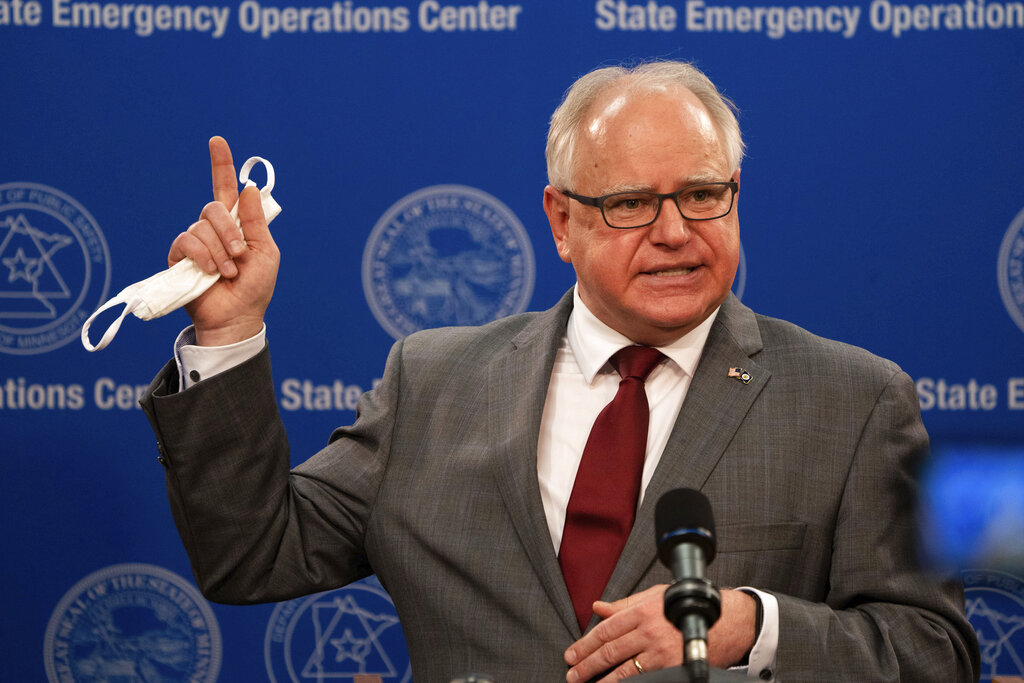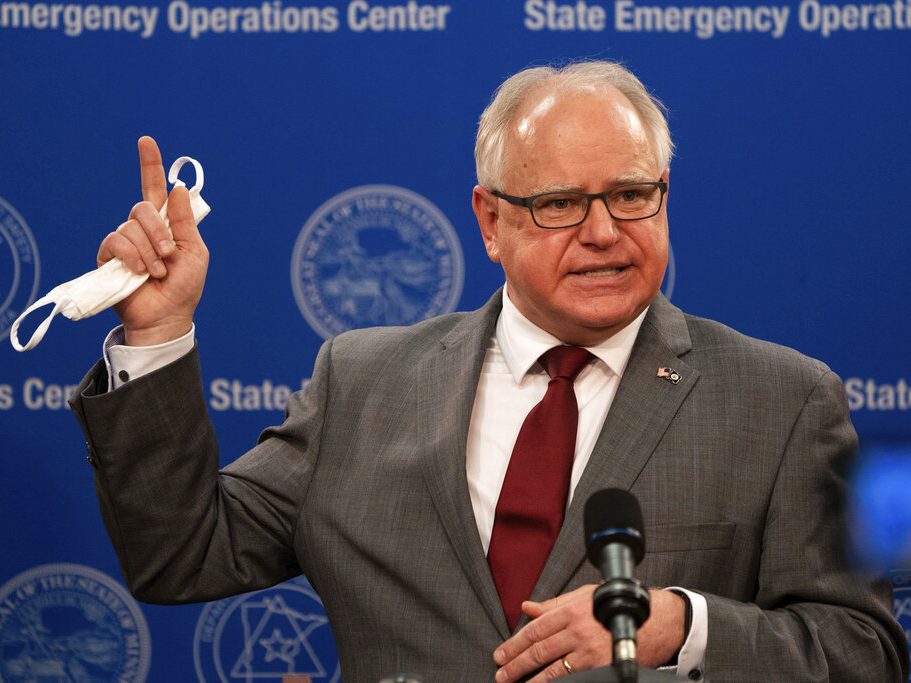
FILE – In an April 30, 2020 file photo, Minnesota Gov. Tim Walz answers questions while holding his mask at a news conference inside the Department of Public Safety in St. Paul, Minn. Walz said Wednesday, May 13, 2020 he will let his stay-at-home order expire as scheduled Monday, though he’ll leave key restrictions in place to keep up Minnesota’s fight against the COVID-19 pandemic. (Evan Frost/Minnesota Public Radio via AP, Pool, File)
MINNEAPOLIS (AP) — Gov. Tim Walz said Wednesday he will let his stay-at-home order expire as scheduled Monday, though he’ll leave key restrictions in place to keep up Minnesota’s fight against the COVID-19 pandemic.
“Don’t get me wrong — we believe that the safest place we can be is at home,” Walz said in a televised address. “But we know we can’t continue like this forever.”
Walz made the announcement after health officials released updated modeling — couched in caveats — that showed the potential effects of various scenarios he could have chosen. The Democratic governor has been under increasing political pressure to loosen up the restrictions, and some business owners have threatened defiance if they remain in place.
Walz said his new order brings back some of the social interactions “that are so important in life.”
But the governor said in a statement, “This is not the time for sudden movements.”
“We are not flipping a switch and going back to normal all at once. We are slowly moving a dial and introducing more interaction between people over time,” Walz said.
While the stay-at-home order will expire, the changes he announced amount to only a gradual relaxation of the state’s restrictions. Bars, restaurants, and other places where people gather in large numbers won’t be allowed to reopen for business as usual just yet. But gatherings of 10 people or fewer such as family celebrations will be allowed. Retailers that had been shuttered as nonessential will be allowed to reopen with restrictions on how many people can be allowed inside.
Under Walz’s new “Stay Safe MN” order, Minnesotans still will be asked to stay close to home and limit themselves to essential travel. An additional executive order allows retail stores, malls and Main Street businesses to reopen for in-store shopping if they have social distancing in place for workers and customers and are at no more than 50% occupant capacity.
The Department of Employment and Economic Development estimates that will allow up to 37,000 more workers to return to work over the next several weeks.
“Malls will be open,” Walz told reporters. But he added, “We certainly don’t want people hanging out in the food court and doing things.”
Walz also directed his cabinet to come up with ways to safely reopen bars, restaurants, barbershops and salons starting June 1.
The governor also extended his peacetime emergency declaration until June 12. The emergency declaration gives Walz continued authority to take steps without legislative approval to slow the spread of the coronavirus.
Senate Majority Leader Paul Gazelka, a Republican from East Gull Lake, said he supported Walz’s decision to lift the stay-at-home order.
“We’re moving in the right direction,” Gazelka said in a video. “Now it’s up to us, you and me, that we practice safe distancing. I have every confidence we’re going to be able to do it. Minnesota is back on track.”
Minnesota Chamber President Doug Loon called Walz’s decision to end the stay-at-home order “welcome news for businesses throughout the state who are eager to get our economy moving again.”
But House Minority Leader Kurt Daudt, a Republican from Crown, said Walz’s decision to lift his stay-at-home order comes too late for some Minnesota businesses, “and their doors will never reopen.”
The Minnesota Department of Health and the University of Minnesota School of Public Health on Wednesday presented the third version of the model that they’ve used to help guide the state’s response to the pandemic, and the updated model is certain to fuel the debate. While the previous model assumed the stay-at-home restrictions would reduce person-to-person contacts by 80%, the new model works off data showing a 59.5% drop in person-to-person contacts and projects somewhat higher death rates.
Health Department officials stressed that the modeling is just part of the information guiding their decisions and cautioned against putting too much stock in any of the numbers, which carry a wide range of uncertainty. Health Commissioner Jan Malcolm said the model is best used to illustrate broad directional trends instead.
“I share the hope with you that we are wrong and that this is a pessimistic outcome of the model,” said State Health Economist Stefan Gildemeister. “Nevertheless, we think it is a plausible outcome.”
Confirmed cases of coronavirus infections continue to rise in Minnesota. The department reported 431 new cases Wednesday for a total of 12,917 statewide, and 24 additional deaths among confirmed patients for a total of 638. The department also reported nine probable COVID-19 deaths. It was the first time the department has released a figure for deaths among people not documented to have tested positive.

